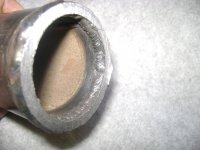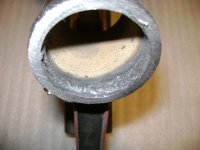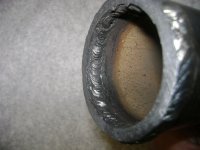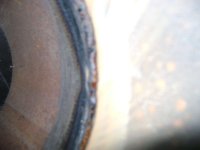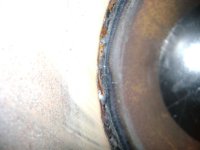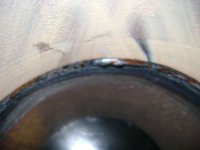Help me understand, if you will please, about capability and when beveling is needed.
My Millermatic 211 is supposed to weld up to 3/8" in a single pass (not that I mind multiple passes). If I'm trying to weld a butt joint on 1/4", do I need to bevel the edges? Is it too much to expect full penetration without bevelling? Can I make an adequately strong weld by doing both sides without full penetration? How much penetration do I need for a good joint?
What do they mean by "welding up to 3/8" in a single pass?" A 3/16" fillet on both sides of a tee joint or lap joint?
Thanks,
Ken
i'd like to throw a little more information at this one. hopefully it will be simple enough to understand and not muddy things up too much...
i'm going to quote information and pages out of the american institute of steel construction 9th edition allowable stress manual which i know most of you won't have access too, so i'll try to paraphrase the gist of the information. sadly, this is an out of date spec for virtually all construction now, but it was the current one when i started in this industry a little over 20 years ago so i can still instantly flip to the page i need. as newer specifications have come out, most of my work was done on computer and i've had far fewer occasions where i needed to look up something in a printed text, therefore it would take me a lot more time to assemble this information. no matter which spec is used, the general information is the same.
in the welded joints section, starting on page 4-152 there is discussion of complete penetration joints. they show examples of the most commonly used complete penetration joint conditions, and consider these types prequalified. by that they mean that assuming these joints are made with proper material under the proper conditions, then they may be exempt from testing, though i find that is often not the case. still, the pictures of the joints show the suggested/required welding.
for your example of splicing two plates, here is the information:
joint designation B-L1b allows material up to 1/4" to be spliced with no beveling, provided that a 1/8" gap is left between the pieces of material. this joint is made by welding one side of the connection then gouging the back side of the weld, generally with a carbon gouging rod. after any impurities have been removed by gouging the back side is then welded. this joint is for the smaw (stick welding) process.
joint B-L1b-GF allows up to 3/8" thick material to be joined with no beveling and a gap of 0" to 1/8". this still requires the same weld/gouge/weld procedure and is allowable for gmaw (mig) and fcaw (flux core) wire feeders, though short circuit transfer is specifically excluded from this and all other prequalified welds that do not use a backer. short circuit transfer is what most of us are using with our light duty welders.
processes B-U2/B-U2-GF and B-U4b/B-U4b-GF are for splicing material while beveling one (45 degrees) or both (30 degrees each) pieces with a gap of 0" to 1/8". these can be done with smaw. gmaw, or fcaw welding on any thickness material. thick material will require multiple passes of weld. these are still accomplished with a weld/gouge/weld procedure and short circuit transfer is still excluded as a prequalified solution.
the thing to remember is that these are what is used for building and bridge construction by large fab shops. what we do in our homes very rarely mimics this. as you can see, to achieve complete penetration all of these welds are done from both sides and require backgouging. this is not to say that you can't achieve complete penetration from a single side welding, because some industries such as pipeline welding don't have the luxury of being able to weld from the back side, but these two sided welds are done on a daily basis by many large fab shops.
the question of when you need a full penetration weld is one that is virtually impossible to answer. every condition is different but your best friends are experience and observation. look at other similar commercially made products and see how they are done. short of a complete structural analysis you'll never know exactly what you need. the most likely needs for complete penetration are for repairing a piece of metal that broke (not a broken weld) or when you need to splice a piece of metal because you don't have one full piece that is big enough.
on the issue of 3/8" in a single pass... that's so vague you have to make assumptions everywhere. does that mean for 70ksi filler metal? is it for tension or shear? is it for a single sided or double sided weld? is it for 36ksi yeild/58ksi tensile steel? one thing i am pretty sure of is that it isn't a complete penetration weld of 3/8" material in a single pass.
because of the nature of what i do, i find that i look at how literally everything is built - it's just how i am wired. i notice bolts, welds, material thicknesses and so on. i find that very little actually needs to be done with a complete penetration weld.
